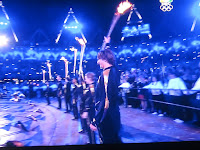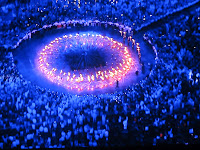This time we are going to space with the new Curiosity Robot in a NASA mission to Mars. Watch an animated movie that already happened with the launching of the robot last August 12th
And if you want the whole movie about project Curiosity, here I offer you the story of the new martian rover:
From the Associated Press:
PASADENA, Calif. — In a show of technological wizardry, the robotic explorer Curiosity blazed through the pink skies of Mars, steering itself to a gentle landing inside a giant crater for the most ambitious dig yet into the red planet’s past.
A chorus of cheers and applause echoed through the NASA Jet Propulsion Laboratory on Sunday night after the most high-tech interplanetary rover ever built sent a signal to Earth. Minutes earlier, it had been in a harrowing plunge through the thin Mars atmosphere.
It was NASA’s seventh landing on Earth’s neighbor; many other attempts by the U.S. and other countries to zip past, circle or set down on Mars have gone awry.
The arrival was an engineering tour de force, debuting never-before-tried acrobatics packed into “seven minutes of terror” as Curiosity sliced through the Martian atmosphere at 13,000 mph.
In a Hollywood-style finish, cables delicately lowered the rover to the ground at a snail-paced 2 mph. A video camera was set to capture the most dramatic moments — which would give earthlings their first glimpse of a touchdown on another world.
The extraterrestrial feat injected a much-needed boost to NASA, which is debating whether it can afford another Mars landing this decade. At a budget-busting $2.5 billion, Curiosity is the priciest gamble yet, which scientists hope will pay off with a bonanza of discoveries.
Over the next two years, Curiosity will drive over to a mountain rising from the crater floor, poke into rocks and scoop up rust-tinted soil to see if the region ever had the right environment for microscopic organisms to thrive. It’s the latest chapter in the long-running quest to find out whether primitive life arose early in the planet’s history.
The voyage to Mars took more than eight months and spanned 352 million miles. The trickiest part of the journey? The landing. Because Curiosity weighs nearly a ton, engineers drummed up a new and more controlled way to set the rover down. The last Mars rovers, twins Spirit and Opportunity, were cocooned in air bags and bounced to a stop in 2004.
The plans for Curiosity called for a series of braking tricks, similar to those used by the space shuttle, and a supersonic parachute to slow it down. Next: Ditch the heat shield used for the fiery descent.
And in a new twist, engineers came up with a way to lower the rover by cable from a hovering rocket-powered backpack. At touchdown, the cords cut and the rocket stage crashed a distance away.
The nuclear-powered Curiosity, the size of a small car, is packed with scientific tools, cameras and a weather station. It sports a robotic arm with a power drill, a laser that can zap distant rocks, a chemistry lab to sniff for the chemical building blocks of life and a detector to measure dangerous radiation on the surface.
It also tracked radiation levels during the journey to help NASA better understand the risks astronauts could face on a future manned trip.
After several weeks of health checkups, the six-wheel rover could take its first short drive and flex its robotic arm.
The landing site near Mars’ equator was picked because there are signs of past water everywhere, meeting one of the requirements for life as we know it. Inside Gale Crater is a 3-mile-high mountain, and images from space show the base appears rich in minerals that formed in the presence of water.
Previous trips to Mars have uncovered ice near the Martian north pole and evidence that water once flowed when the planet was wetter and toastier unlike today’s harsh, frigid desert environment.
Curiosity’s goal: to scour for basic ingredients essential for life including carbon, nitrogen, phosphorous, sulfur and oxygen. It’s not equipped to search for living or fossil microorganisms. To get a definitive answer, a future mission needs to fly Martian rocks and soil back to Earth to be examined by powerful laboratories.
The mission comes as NASA retools its Mars exploration strategy. Faced with tough economic times, the space agency pulled out of partnership with the European Space Agency to land a rock-collecting rover in 2018. The Europeans have since teamed with the Russians as NASA decides on a new roadmap.
Despite Mars’ reputation as a spacecraft graveyard, humans continue their love affair with the planet, lobbing spacecraft in search of clues about its early history. Out of more than three dozen attempts — flybys, orbiters and landings — by the U.S., Soviet Union, Europe and Japan since the 1960s, more than half have ended disastrously.
One NASA rover that defied expectations is Opportunity, which is still busy wheeling around the rim of a crater in the Martian southern hemisphere eight years later.
Pages
▼
jueves, 9 de agosto de 2012
Opening Ceremony of the Olympic Games 2012 in London
This information has been collected from Wikipedia and videos are from You Tube. The pictures and Paul Mac Cartney's show video are mine and have been taken directly from my camera while watching a TV transmission of the Opening Ceremonies.
The 2012 Summer Olympic Games, officially the Games of the XXX Olympiad, also known informally as London 2012, began in London, United Kingdom on 27 July and will continue until 12 August 2012.
Construction in preparation for the Games involved considerable redevelopment, particularly themed towards sustainability. The main focus is a new 200 hectares (490 acres) Olympic Park, constructed on a former industrial site at Stratford, East London
The original budget for the Games was £2.4 billion, but this was increased almost fourfold to about £9.3 billion ($14.46 billion) in 2007.
Unpaid volunteers known as Games Makers will perform a variety of tasks before and during the Games.Sebastian Coe said in February 2012, "Our Games Makers will contribute a total of around eight million volunteer hours during the Games and the Games simply wouldn't happen without them".
In Great Britain, ticket prices range from £20 for many events to £2,012 for the most expensive seats at the opening ceremony. Free tickets were given to military personnel, as well as to survivors and families of those who died during 7 July 2005 London bombings Eventually, more than 7,000,000 tickets were sold.
The cost of security has also increased from £282 million to £553 million. This will be the biggest security operation Britain has faced for decades. The figure of 13,500 armed forces personnel is more than Britain currently has deployed in Afghanistan
Approximately 4,700 Olympic and Paralympic medals have been produced by the Royal Mint at Llantrisant.
They were designed by David Watkins (Olympics) and Lin Cheung (Paralympics).
Each gold medal is made up of 92.5 percent silver and 1.34 percent gold, with the remainder copper. The silver medal (which represents second place) is made up of 92.5 percent silver, with the remainder copper. The bronze medal is made up of 97 percent copper, 2.5 percent zinc and 0.5 percent tin. The value of the materials in the gold medal is about $644, the silver about $330, and the bronze about $4.71 on the current market.The opening ceremony of the 2012 Summer Olympics was held on 27 July and called "Isles of Wonder". Oscar-winning director Danny Boyle was its artistic director, with the music directors being the electronic music duo Rick Smith and Karl Hyde of Underworld.
The Games were officially opened by Queen Elizabeth II, accompanied by Prince Philip, Duke of Edinburgh
A short comic film starring Daniel Craig as secret agent James Bond and the Queen as herself was screened during the ceremony, as was a gentle mockery of the event in the shape of Rowan Atkinson playing Chariots of Fire.
Another popular video was that of Mr. Bean and the London Symphony Orchestra
Sir Paul McCartney performed the song "Hey Jude" at the end of the ceremony
According to reports, the gala opening ceremonywas watched by 27 million UK viewers, and it had a final cost of 27 billion dollars.
The Olympic flame arrived on flight BA2012 on 18 May 2012 from Greece.[105] The relay lasted 70 days, with 66 evening celebrations and six island visits, and involved about 8,000 people carrying the torch a distance of about 8,000 miles (12,800 km), starting from Land's End in Cornwall.[106] The closing ceremony of the London 2012 Summer Olympics is scheduled to take place on 12 August 2012. The ceremony is planned to include a handover of the Olympic flag by Boris Johnson, Mayor of London, to Eduardo Paes, Mayor of Rio de Janeiro, the host city of the 2016 Summer Olympics.[123]
Around 10,500 athletes from 204 National Olympic Committees (NOCs) are expected to participate.
This is a group of pictures which I took from the Inaguration of the Olympic Games 2012 in London.



























































